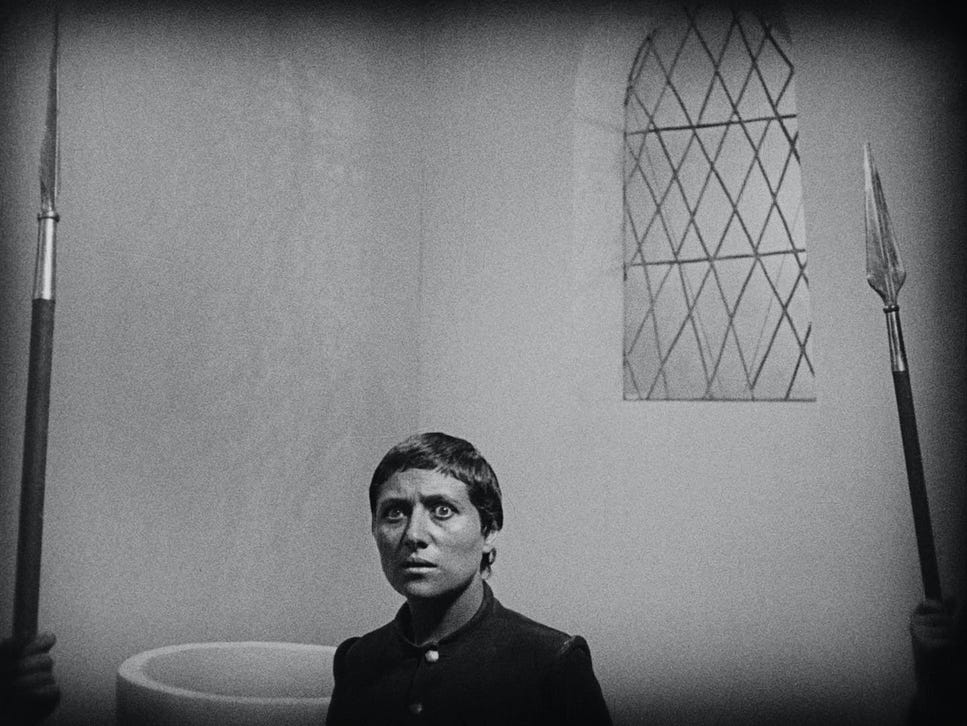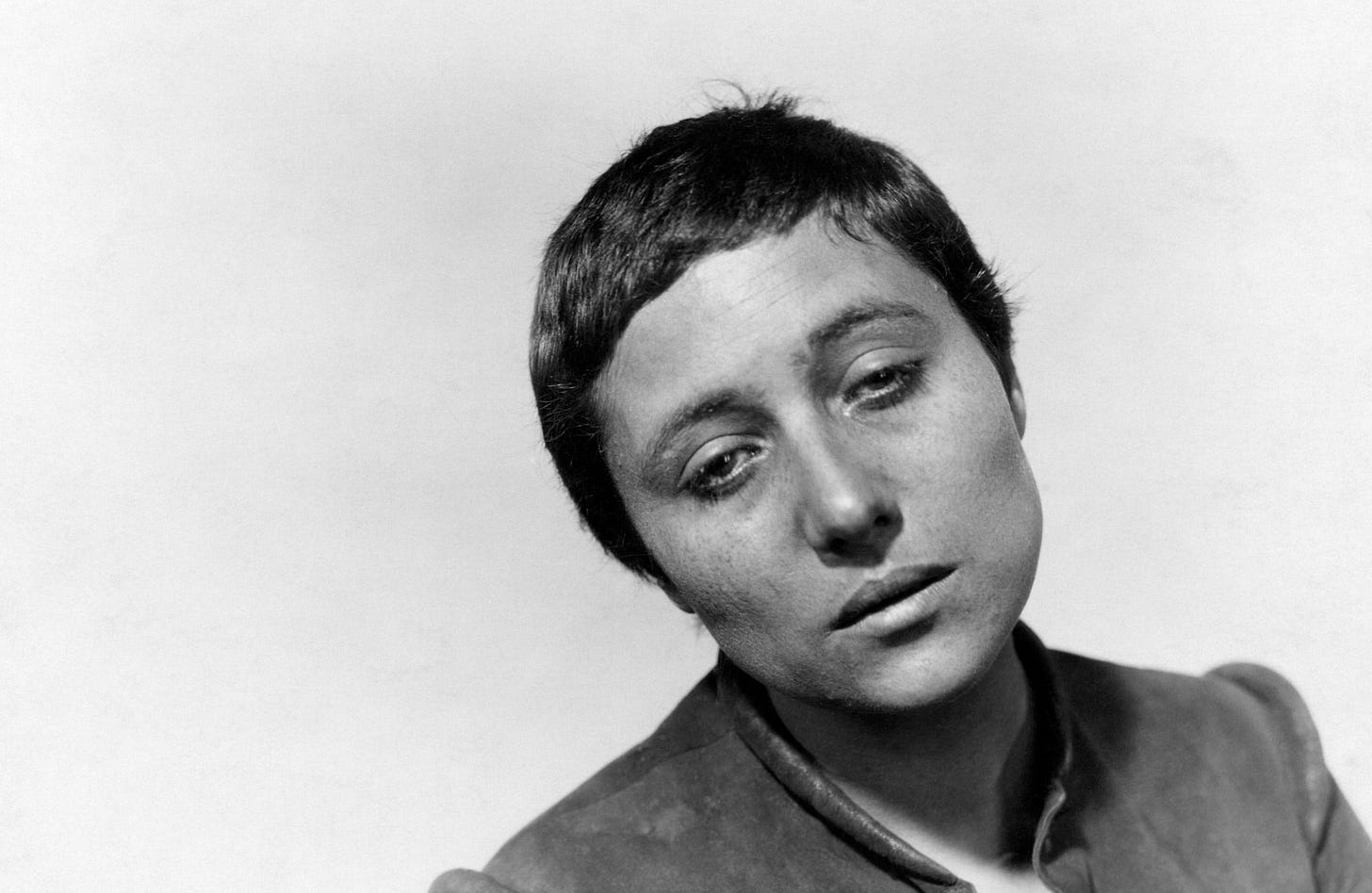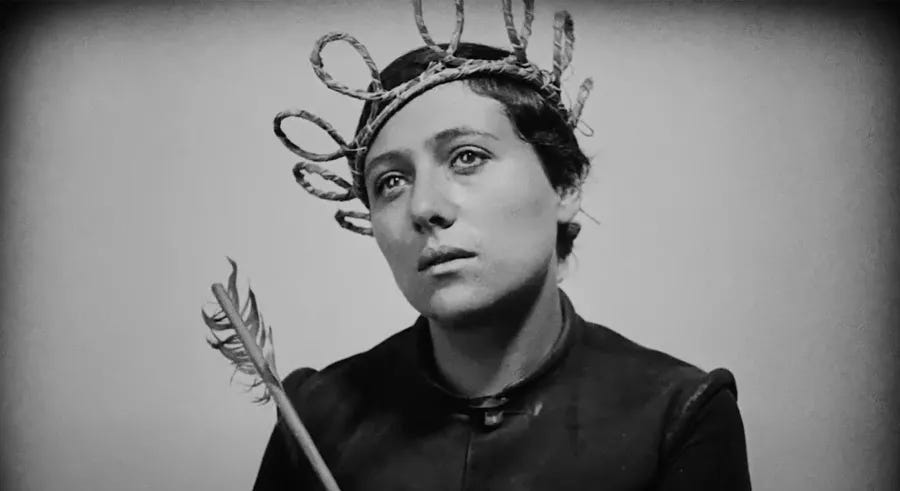Directed by Carl Theodor Dreyer
France, 1928
You know the story of Joan of Arc don’t you? If not, you should. It’s the early 15th century and England and France are embroiled in the Hundred Years’ War. A peasant girl from a French village hears what she believes are voices from God. She somehow convinces the royal court to give her a military command and leads the French army to a momentous victory against the English. One year later, Joan – now known as the Maid of Orléans – was captured, sold to the English, and put on trial for heresy. She was just 19 years old when she was burned at the stake. Revered today by the French as a national heroine, Joan of Arc was canonised in 1920.
This is a story that really does lend itself to a cinematic treatment and there have been plenty of them: from Ingrid Bergman in the reverent 1948 biopic to Luc Besson’s historical romp, The Messenger, starring Milla Jovovich. Of course, in these films it is the battles that loom large, with Joan storming the ramparts in a glistening breastplate. Carl Theodor Dreyer’s The Passion of Joan of Arc is different. For this 1928 silent film, the Danish director discarded the planned screenplay, eschewing her military exploits. This is a film about Joan’s last days, based – as the prologue titles tell us – on the original transcripts of her trial.
The Passion of Joan of Arc is highly stylised. Months of interrogation are collapsed into a single day. The establishing shot reveals the interior of a castle. Preparations for the trial are underway. English soldiers are milling about, their tin helmets suggest that they have just clambered out of the trenches of the Great War. Clerics file into the courtroom – this is an ecclesiastical court. As Joan enters, we see a diminutive boyish figure, framed by the soldiers’ pikes, her eyes wide with fear. But then, just as he binned the original script, Dreyer swerves into new formal territory. From here on in this becomes a film of faces: faces shot in close-up, and I mean extreme close-up. You can see the dirt underneath Joan’s fingernails as she clasps at her temples. Her inquisitors are short in a harsh, high-contrast light and from a low angle. The light is almost too revealing. With the cracks and craters lining their skin, the men recall the grotesques of Albrecht Dürer's engravings.
When the camera does pull away, something jars. The actors are framed against a plain background that give no real sense of depth – a spartan setting that feels both abstract and disorienting. There is little continuity from frame to frame. The effect is to make you look, and look again, at those faces. And then there is Joan. A fly crawls across her forehead, her cheek flecked with spittle from the hectoring prosecutor. Has any other film come as close in capturing the interior world of a character so unflinchingly?
That Dreyer’s radical approach succeeds is in no small part due to Maria Falconetti’s committed and compelling performance. Falconetti was a stage actor with the Comédie-Française before she was cast by Dreyer in this, her first and only feature film. She has a harsh grandeur: as she endures the trial, the Passion, a succession of frames shows her frightened, crazed, devoted, and touched by a faith that consumes her. What we are witnessing is not just a trial; it’s a duel, not of swords but of convictions.
One striking moment has a notable contemporary resonance. A bishop questions Joan’s attire:
Bishop Cauchon: Why do you wear men's clothing? If we give you woman's clothing, would you wear it?
Joan: When the mission that God has entrusted to me is over, I will again dress as a woman.
The trial presses on:
Judge: Never before in France have we witnessed a monster like her.
Joan: I have never done anyone any harm.
Joan’s nadir comes when she is taken to see the executioner’s scaffold. In the courtyard, a gravedigger has unearthed a human skull crawling with worms. We can see this recognition of death register on her face. She falters, signing a confession denying her divine voices, although her illiteracy makes it unlikely that she understands the script placed before her. She retracts her confession – now she is resolute. Accused of being sent by the Devil, Joan makes the same accusation of her judges.
This woman’s arrogance is outrageous.
And so, Joan is burned at the stake, a montage of unforgettable images. The final intertitle card reads:
The flames sheltered Joan's soul as it rose to heaven – Joan whose heart has become the heart of France... Joan, whose memory will always be cherished by the French people.
And yet the film does not finish on an uplifting note. As the French crowd witness the flames, a cry breaks out, “You have burned a saint!”. The people become restive, her charred body falls away from the blackened execution stake, and the watching soldiers unleash an orgiastic frenzy of violence and slaughter. Dreyer’s cinema anticipates the coming storms of the 20th Century.
I really don’t think it would be an exaggeration to call The Passion of Joan of Arc a masterpiece. It is a bold film, inspiring and formally inventive. A film in which character is plot. The images linger: the face of that peasant girl, just 19 years old, a single tear running down her cheek. She may be a heroine, she may be a martyr, but she is also undeniably human.
I know that this use of the close-up was in open conflict with the theoretical principles which were the basis for filmmaking, but for me the close-ups were absolutely necessary. I don’t know how I could have possibly told the story of Joan’s trial and death if I had not had the help of the close-ups in getting the viewers completely inside of both Joan’s and the judges’ hearts and souls - Carl Theodor Dreyer
I did really like it, performances were great, of course Joan was standout, although she kept doing this look to the heavens, which I’ve seen a lot walking around Bristol recently, likely a result of the spice epidemic… - N
Reids’ Results (out of 100)
C - 83
T - 83
N - 81
S - 90
Thank you for reading Reids on Film. If you enjoyed our review please share with a friend and do leave a comment.
Coming next… 2001: A Space Odyssey(1968)











When I saw "The Passion of Joan of Arc," my watching conditions weren't ideal (Criterion Channel, laptop screen, hospital). I didn't have the emotional epiphany that many people talk about. I'll probably revisit it some day.
One thing I do remember vividly (apart from Maria Falconetti's face, obviously): When Antonin Artaud's name came up in the opening credits, I realized I had no idea what the guy looked like. But the moment he appeared on the screen, I knew without the slightest doubt that *this* was the kind of man who would write "Manifesto of the Theater of Cruelty."
> Accused of being sent by the Devil, Joan makes the same accusation of her judges.
🌱